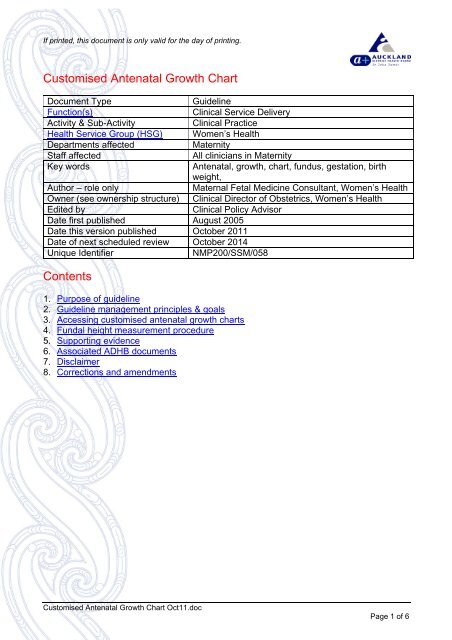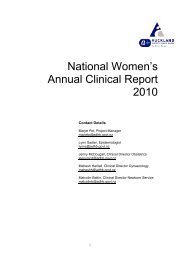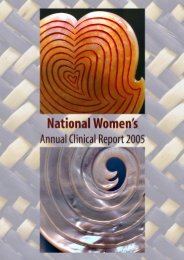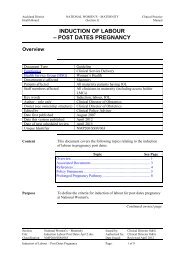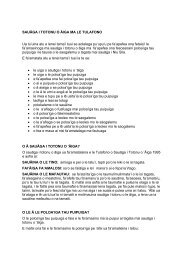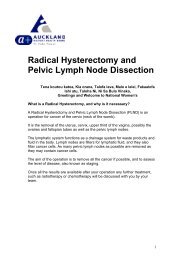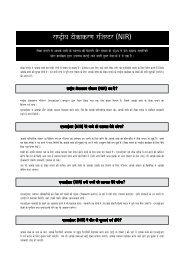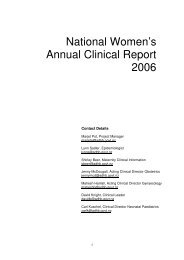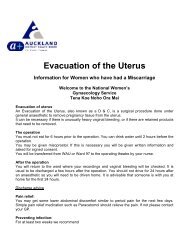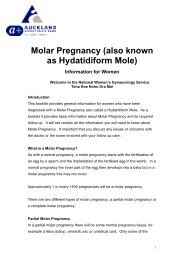Customised Antenatal Growth Chart - National Women's Hospital ...
Customised Antenatal Growth Chart - National Women's Hospital ...
Customised Antenatal Growth Chart - National Women's Hospital ...
You also want an ePaper? Increase the reach of your titles
YUMPU automatically turns print PDFs into web optimized ePapers that Google loves.
If printed, this document is only valid for the day of printing.<br />
<strong>Customised</strong> <strong>Antenatal</strong> <strong>Growth</strong> <strong>Chart</strong><br />
Document Type Guideline<br />
Function(s) Clinical Service Delivery<br />
Activity & Sub-Activity Clinical Practice<br />
Health Service Group (HSG) Women’s Health<br />
Departments affected Maternity<br />
Staff affected All clinicians in Maternity<br />
Key words <strong>Antenatal</strong>, growth, chart, fundus, gestation, birth<br />
weight,<br />
Author – role only Maternal Fetal Medicine Consultant, Women’s Health<br />
Owner (see ownership structure) Clinical Director of Obstetrics, Women’s Health<br />
Edited by Clinical Policy Advisor<br />
Date first published August 2005<br />
Date this version published October 2011<br />
Date of next scheduled review October 2014<br />
Unique Identifier NMP200/SSM/058<br />
Contents<br />
1. Purpose of guideline<br />
2. Guideline management principles & goals<br />
3. Accessing customised antenatal growth charts<br />
4. Fundal height measurement procedure<br />
5. Supporting evidence<br />
6. Associated ADHB documents<br />
7. Disclaimer<br />
8. Corrections and amendments<br />
<strong>Customised</strong> <strong>Antenatal</strong> <strong>Growth</strong> <strong>Chart</strong> Oct11.doc<br />
Page 1 of 6
If printed, this document is only valid for the day of printing.<br />
1. Purpose of guideline<br />
This guideline establishes the correct procedure for measurement of fundal height<br />
within Auckland District Health Board (ADHB) and for use of a customised growth chart<br />
to aid interpretation of fundal height and ultrasound estimated fetal weight.<br />
2. Guideline management principles & goals<br />
<strong>Customised</strong> <strong>Antenatal</strong> <strong>Growth</strong> <strong>Chart</strong> Oct11.doc<br />
Back to Contents<br />
Each pregnant woman should be provided with a customised growth chart that<br />
estimates the expected growth in fundal height for her individual pregnancy. Fundal<br />
height measurements should be recorded from 24 weeks onwards and should not be<br />
plotted more frequently than fortnightly.<br />
Women over 100kg<br />
For women >100 Kg, fundal height measurements are not reliable but estimated fetal<br />
weight measurements from growth scans should be plotted. <strong>Growth</strong> scans in women ><br />
100kg should be performed if clinical assessment is not possible because of body<br />
habitus (which is often the case). Suggested gestations for ultrasound growth<br />
assessment are 30 and 36 weeks for women > 100kg when SGA cannot be excluded<br />
clinically.<br />
Fundal height > 90 th centile<br />
When fundal height is >90 th centile it is important to ensure that appropriate diabetes<br />
testing has been performed and if there is concern re polyhydramnios a scan should be<br />
performed. There are no other evidence based interventions for management of the<br />
baby that is suspected to be LGA and therefore referral is not usually indicated. Note<br />
the primary purpose of the customised antenatal growth charts is to increase antenatal<br />
detection of SGA babies.<br />
See flowchart: Diabetes Screening<br />
Women at high risk of SGA<br />
Women at high risk of SGA e.g. previous SGA baby
If printed, this document is only valid for the day of printing.<br />
3. Accessing customised antenatal growth charts<br />
At booking interview, measure the woman’s weight, height, record her ethnicity, LMP<br />
and EDD. Also record the weight, gestation at delivery and sex of any previous babies<br />
From within the ADHB network:<br />
i. Press the start menu on your computer and select programs<br />
ii. From the programs menu select GROW<br />
iii. Select “enable macros”<br />
If outside ADHB, there are a number of ways to access the GROW programme, for<br />
further information go to www.gestation.net.<br />
i. Complete the data requested<br />
ii. The programme will calculate the woman’s BMI<br />
iii. Enter birth weight, infant sex and gestation at delivery for any previous<br />
babies and a birth weight centile will be generated for them<br />
iv. The customised chart will then appear on the screen with a graph of the<br />
optimal fundal height and estimated fetal weight measurements for the<br />
current pregnancy<br />
v. Enter the woman’s estimated delivery date<br />
vi. Press print<br />
vii. Add chart to the woman’s clinical record<br />
Note if a previous infant had a birth weight
If printed, this document is only valid for the day of printing.<br />
4. Fundal height measurement procedure<br />
1. Mother semi-recumbent, with bladder empty.<br />
2. Palpate to determine fundus with two hands.<br />
3. Secure tape with hand at top of fundus.<br />
<strong>Customised</strong> <strong>Antenatal</strong> <strong>Growth</strong> <strong>Chart</strong> Oct11.doc<br />
• Explain the procedure to the<br />
mother and gain verbal consent<br />
• Wash hands<br />
• Have a non-elastic tape measure<br />
to hand<br />
• Ensure the mother is comfortable<br />
in a semi-recumbent position, with<br />
an empty bladder<br />
• Expose enough of the abdomen to<br />
allow a thorough examination<br />
• Ensure the abdomen is soft (not<br />
contracting)<br />
• Perform abdominal palpation to<br />
enable accurate identification of<br />
the uterine fundus.<br />
• Use the tape measure with the<br />
centimetres on the underside to<br />
reduce bias<br />
• Secure the tape measure at the<br />
fundus with one hand<br />
Page 4 of 6
If printed, this document is only valid for the day of printing.<br />
4. Measure to top of symphysis pubis.<br />
<strong>Customised</strong> <strong>Antenatal</strong> <strong>Growth</strong> <strong>Chart</strong> Oct11.doc<br />
• Measure from the top of the fundus<br />
to the top of the symphysis pubis<br />
• The tape measure should stay in<br />
contact with the skin<br />
5. Measure along longitudinal axis of uterus, note metric measurement.<br />
6. Plot on customised chart, record in notes<br />
•<br />
• Measure along the longitudinal<br />
axis without correcting to the<br />
abdominal midline<br />
• Measure only once<br />
• Record the metric measurement<br />
and plot it on the growth chart<br />
and record the fundal height<br />
measurement in the antenatal<br />
records<br />
Back to Contents<br />
Page 5 of 6
If printed, this document is only valid for the day of printing.<br />
5. Supporting evidence<br />
A UK study showed an increased detection of small for gestational age (SGA) babies<br />
from 29% in the control group to 48% in the group with a customised growth chart. An<br />
audit from the community clinic at <strong>National</strong> Women’s health found that 60% of women<br />
with a customised growth chart had their SGA babies recognised before birth<br />
compared with 10% detection in mothers without a customised growth chart .The<br />
gestation related optimal weight (GROW) programme can now be applied to New<br />
Zealand ethnic groups. It is likely that there will be less intervention in babies that are<br />
physiologically small such as some Indian and Asian babies.<br />
www.perinatal.nhs.uk/<br />
www.gestation.net<br />
Gardosi J, Francis A. Controlled trial of fundal height measurement plotted on<br />
customised antenatal growth charts. B J Obstet Gynae 1999; 106:309-17<br />
McCowan L, Stewart AW, Francis A, Gardosi J. A customised birth weight centile<br />
calculator developed for a New Zealand population. Aust NZ J Obstet Gynaecol. 2004;<br />
44: 428-431<br />
McCowan L, Stewart AW. Term birth weight centiles for babies from New Zealand’s<br />
main ethnic groups. Aust NZ J Obstet Gynaecol. 2004; 44: 432-435<br />
Back to Contents<br />
6. Associated ADHB documents<br />
Protocol for IUGR Management in Day Assessment Unit<br />
Referral – Maternal Fetal Medicine<br />
Flowchart: Diabetes Screening<br />
7. Disclaimer<br />
No guideline can cover all variations required for specific circumstances. It is the<br />
responsibility of the health care practitioners using this ADHB guideline to adapt it for<br />
safe use within their own institution, recognise the need for specialist help, and call for<br />
it without delay, when an individual patient falls outside of the boundaries of this<br />
guideline.<br />
8. Corrections and amendments<br />
<strong>Customised</strong> <strong>Antenatal</strong> <strong>Growth</strong> <strong>Chart</strong> Oct11.doc<br />
Back to Contents<br />
The next scheduled review of this document is as per the document classification table<br />
(page 1). However, if the reader notices any errors or believes that the document<br />
should be reviewed before the scheduled date, they should contact the owner or the<br />
Clinical Policy Advisor without delay.<br />
Back to Contents<br />
Page 6 of 6


